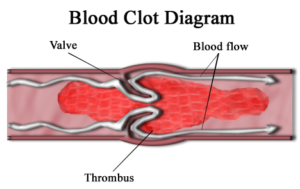
By Gabriel Skaggs and Dylan Walter; Farnsley Middle School (Louisville, KY)
“It was really hard to breathe.” said Ronnie Walter, co-author Dylan’s Dad. “When I got to the hospital my doctor found out I had a pulmonary embolism, and that I was very lucky to live. That made me scared. We went to the emergency room, and they hooked up all kinds of machines up to my nose to allow me to breath.”
According to the Mayo Clinic, a pulmonary embolism (PE) is caused by a blood clot in the leg that becomes loose and travels to the lungs. (Pulmonary means related to the lungs. Embolism means blocking of an artery, usually by a blood clot or an air bubble.) This can be quite dangerous if not treated properly.
“The blocks can be caused by fat from marrow from a broken collagen [structural protein] or other tissue, part of a tumor, and air bubbles,” states Mayo Clinic. If you wait 3 to 4 days to get treated, there is a high chance of death.
According to WebMD, “The major symptoms are fast heart rate, shortness of breath, chest pain, and coughing a lot. There can also be leg pain, or swelling or both, usually in the calf.” If you have these symptoms you need to go to a doctor right away, your life could be in danger. About 30,000 Americans die each year from PE in the U.S.
According to Mayo Clinic, one reason for PE is Deep Vein Thrombosis (DVT blood clot). A DVT blood clot is when a blood clot gets deep in one of the veins.
Another cause of PE is inactivity, if you’re not active it could stop your blood from flowing properly.
PE can also occur when your blood doesn’t flow properly. If it pools in your heart or blood vessels, the platelets are more likely to stick together.
According to Mayo Clinic, “If one of your parents experienced PE Blood clots often, you have a higher chance to experience them than people who have had parents who did not.” Another cause is if you are hurt and sit down for a long time without any movement a clot can form and go to your lungs.
PE Blood clots have a treatment. One treatment is thrombolytic treatment, to dissolve clots with drugs. One more treatment for PE is surgery in which doctors remove the embolic—a blood clot, air bubble, piece of fatty deposit, or other object which has been carried in the bloodstream to lodge in a vessel and cause an embolism. One last treatment for Pulmonary Embolism is getting a filter put in the vena cava so it can stop any blood clots before they reach your lungs.
According to Angie Johnson, a resource teacher at Farnsley Middle School who has personal knowledge of this, if you have any type of blood clot you avoid eating foods with vitamin K, such as kale, spinach, turnip greens, swiss chard, or any green leafy vegetables. This is because vitamin K thickens the blood causing blood clots or making them worse.
After four day, Ronnie Walter got out of the hospital free of PE and mostly healthy. “Even though I was feeling weak when I got out of the hospital, I felt great. And I was just glad to not be at the hospital any longer.” Now Ronnie Walter does not have PE anymore, although he has a higher risk of getting it again than most.

This work is licensed under a Creative Commons Attribution-NonCommercial-NoDerivs 3.0 Unported License.













